Trigger Finger
Patient Education
Overview
Trigger finger is a fairly common condition, where the affected finger is stuck in a bent position. It can cause pain, stiffness and a sensation of locking or catching when you bend and straighten the finger. The condition is also known as “stenosing tenosynovitis.” While the condition can occur in any fingers, the ring finger and thumb are most often affected.

Fig. 1 – Trigger finger of the ring finger.
Causes
Trigger finger occurs when the sheath surrounding the tendon becomes irritated and inflamed. This inflammation blocks the tendon from effectively gliding through the sheath, therefore, keeping the affected finger in a bent position.
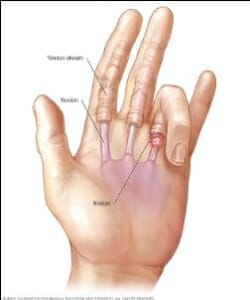
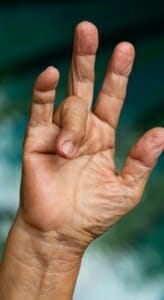
Fig. 2 – Trigger finger generally results from inflammation within the tendon sheath,
restricting tendon motion. A bump (nodule) in the tendon may also form.
While the causes of trigger finger are not well known, several factors may increase one’s risk for developing a trigger finger or trigger thumb. These include:
- Repeated gripping – occupations or hobbies that demand repetitive hand motion or prolonged gripping may increase your risk of developing trigger finger. Excessive swiping and typing of the thumb while using a smartphone have also emerged new cases of trigger thumb, known as “smartphone tendinitis.”
- Medical conditions – people who have diabetes or rheumatoid arthritis are also at higher risk for trigger finger.
- Gender – female are more likely to have trigger finger.
- Carpal tunnel syndrome surgery – trigger finger may be a complication associated with carpal tunnel surgery during the first 6 months post surgery.
Symptoms
Signs and symptoms of trigger finger often begins without a single injury and may progress from mild to severe. Symptoms may include:
- Finger stiffness, particularly after a period of inactivity, such as in the morning.
- A tender lump or nodule may appear at the base of the affected finger on the palm side of the hand.
- Pain when you bend and straighten the finger.
- A popping or clicking sensation as you move your finger.
- Finger catching or locking in a bent position suddenly pops straight.
- Finger stays locked in a bent position and unable to straighten.
Doctor Examination
Often X-rays and other tests are not needed to diagnose trigger finger. Your doctor will be able to arrive at a diagnosis by discussing your symptoms and examining your hand.
During the exam, your doctor will check for:
- Tenderness over the flexor tendon sheath in the palm side of your hand.
- Any thickening or swelling of the tendon sheath.
- Catching or locking of the finger.

Fig. 3 – During your hand exam, your doctor will look for signs of stiffness and locking.
Treatment
When left untreated, prolonged irritation of the tendon sheath can produce scarring, thickening and the formation of nodules can further impede the tendon’s motion.
Nonsurgical Treatment
Initial treatment for trigger finger is often nonsurgical. Which includes:
- Rest. Resting and avoiding repetitive motion that is known to make it worse may be enough to improve your condition.
- Splinting. It may be helpful to wear a splint at night when you sleep to keep the affected finger in extended position.
- Exercises. Gentle exercises using a rubber band can help decrease stiffness and increase your range of motion.
- Medications. Over-the-counter nonsteroidal anti-inflammatory drugs (NSAIDs), such as ibuprofen (Advil, Motrin) and naproxen (Aleve, Naprosyn) can help relieve pain and inflammation.
- Steroid injections. A combination of corticosteroid, a powerful anti-inflammatory agent, and local anesthetic can be injected into the tendon sheath to temporary resolve trigger finger for several weeks. If the symptoms do not improve over time, a second injection may be given. If results are insufficient after the second injection, surgery may be warrant by your hand specialist.
- Notice: Steroid injection can cause a short-term rise in blood sugar. Diabetic patients should closely monitor their glucose levels after an injection.
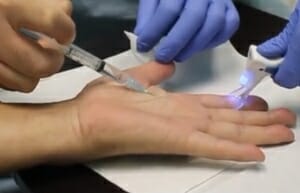
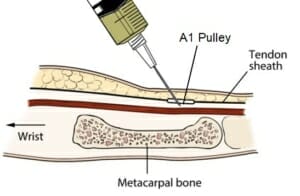
Fig. 4 – Dr. Tran performs steroid injection to the A1 Pulley of the trigger finger.
Surgical Treatment
If nonsurgical treatments did not help improve your condition, your hand surgeon will consider surgery based on the level of pain or loss of function you may have. Your doctor may also recommend surgery if your finger or thumb is stuck in a bent position to prevent permanent stiffness.
The surgical procedure performed to treat trigger finger is called “tenolysis,” or also known as “trigger finger release.” During this procedure, your surgeon will make an incision to the A1 pulley to release the blockage and allow the flexor tendon to glide through the tendon sheath more easily.
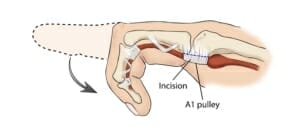
Fig. 5 – During trigger release surgery, the A1 pulley is divided along the blue dotted line.
- Complications: while complications can occur with any surgery, your surgeon will take specific measures to prevent them. The most common complications are stiffness, inability to straighten the treated finger and temporary soreness or swelling. Less common complications may include persistent locking and clicking, bowstringing that reduces range of motion, digital nerve injury and infection (rare).
- Recovery: for your most optimal recovery, make sure to follow your doctor’s post-operative instructions. Most patients are encouraged to move their fingers immediately after surgery. Although your incision will heal within a few weeks, it may take 4 to 6 months for swelling and stiffness in your finger to completely diminish.
- Outcome: most patients experience significant improvement in function and relief of pain after surgery. However, patients who present severe locking of trigger finger before surgery may not be able to remain full range of motion.
Click to Watch Video of Trigger Finger Injection in our Office
References:
Bates, T., & Dunn, J. (2020, April 13). Trigger Finger. Orthobullets. https://www.orthobullets.com/hand/6027/trigger-finger
Mayo Clinic. (2021). Trigger finger. Retrieved from https://www.mayoclinic.org/diseases-conditions/trigger-finger/symptoms-causes/syc-20365100
Norton Healthcare. (2020) Trigger finger treatment without surgery. [Photograph]. https://nortonhealthcare.com/news/trigger-finger-treatment-without-surgery/
OrthoInfo. (2020). Diseases & conditions: Smartphone tendinitis – an emerging problem. Retrieved from https://orthoinfo.aaos.org/en/diseases–conditions/ortho-pinion-smartphone-tendinitis/
OrthoInfo. (2020). Diseases & conditions: Trigger finger. Retrieved from https://orthoinfo.aaos.org/en/diseases–conditions/trigger-finger/


